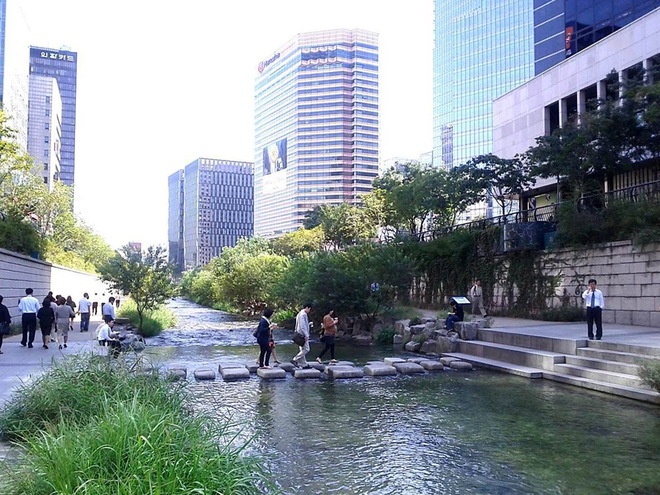페이지 정보
본문

South Korea's Four Rivers Restoration
In the 1970s South Korea were heavily polluted. The major rivers in Korea have suffered from chronic problems of sedimentation, water pollution, water scarcity and poor ecosystems for many years. Korea was experience drought and flood every year, because the government didn't invest enough money to cope with that. Korea has particular issues that require significant solutions.
In 2009, the President of South Korea, Lee Myung-bak, announced a Green Growth Policy, a national grand scheme to ensure environmental and economic sustainability in an era of climate change, 4 rivers restoration. The restoration focused, as its name suggests, on four of the country's biggest rivers – the Han, Nakdong, Geum and Yeongsan, as well as hundreds of miles of tributary streams.
The work is part of South Korea's "Green New Deal" policy, which aims to stimulate the economy after the 2008 financial crisis. The Four Major Rivers project has several aims: securing abundant water resources to protect against potential water scarcity, comprehensive flood control, improving water quality and restoring river ecosystems, creating multi-use open spaces for people in the many communities along the rivers and their tributaries.
The project started in 2009 and finished in 2012. The project has three phases – the first, critical phase involved restoring the four major rivers of the project's name. The second phase involved restoring the 14 tributaries to these rivers.
Phase three of the project will revitalize the many small, local streams that feed into the larger river systems. The flood prevention aspect of the project was tackled by creating floodplains. Rapid intervention against floods and significant reductions in flood levels are being achieved by increasing the number of water gates along the estuary banks.
Like many other river development projects, the project faces some opposition from environmental organizations. Environmental activists demand that the present river systems be kept intact. Environmental assessment of the project revealed that temporary damage to the river ecosystems cannot be fully avoided during the dredging work. However, it also revealed that the river environment will become more health and diverse within a few years.
Not many countries have embraced such significant, major civil engineering projects in parallel with substantial rainwater harvesting on this extraordinary scale, and certainly not over such a relatively short period of time. Such projects, under equally dedicated and high-profile proponents, intelligently combine a range of aims that include resolving the two most pressing issues facing the country flooding and water scarcity. The work undertaken certainly gives weight to the view that South Korea is taking a global leadership role in facing these challenges.

Recorded by Putri
28 May 2022
Script
In the 1970s South Korea were heavily polluted. The major rivers in Korea have suffered from chronic problems of sedimentation, water pollution, water scarcity and poor ecosystems for many years. Korea was experience drought and flood every year, because the government didn't invest enough money to cope with that. Korea has particular issues that require significant solutions. In 2009, the President of South Korea, Lee Myung-bak, announced a Green Growth Policy, a national grand scheme to ensure environmental and economic sustainability in an era of climate change, 4 rivers restoration. The restoration focused, as its name suggests, on four of the country's biggest rivers – the Han, Nakdong, Geum and Yeongsan, as well as hundreds of miles of tributary streams. The work is part of South Korea's "Green New Deal" policy, which aims to stimulate the economy after the 2008 financial crisis. The Four Major Rivers project has several aims: securing abundant water resources to protect against potential water scarcity, comprehensive flood control, improving water quality and restoring river ecosystems, creating multi-use open spaces for people in the many communities along the rivers and their tributaries. The project started in 2009 and finished in 2012. The project has three phases – the first, critical phase involved restoring the four major rivers of the project's name. The second phase involved restoring the 14 tributaries to these rivers. Phase three of the project will revitalize the many small, local streams that feed into the larger river systems. The flood prevention aspect of the project was tackled by creating floodplains. Rapid intervention against floods and significant reductions in flood levels are being achieved by increasing the number of water gates along the estuary banks. Like many other river development projects, the project faces some opposition from environmental organizations. Environmental activists demand that the present river systems be kept intact. Environmental assessment of the project revealed that temporary damage to the river ecosystems cannot be fully avoided during the dredging work. However, it also revealed that the river environment will become more health and diverse within a few years. Not many countries have embraced such significant, major civil engineering projects in parallel with substantial rainwater harvesting on this extraordinary scale, and certainly not over such a relatively short period of time. Such projects, under equally dedicated and high-profile proponents, intelligently combine a range of aims that include resolving the two most pressing issues facing the country flooding and water scarcity. The work undertaken certainly gives weight to the view that South Korea is taking a global leadership role in facing these challenges.
첨부파일
-
WhatsApp Audio 2022-05-28 at 09.33.47.mp4 (4.3M)
1회 다운로드 | DATE : 2022-05-28 09:34:37
